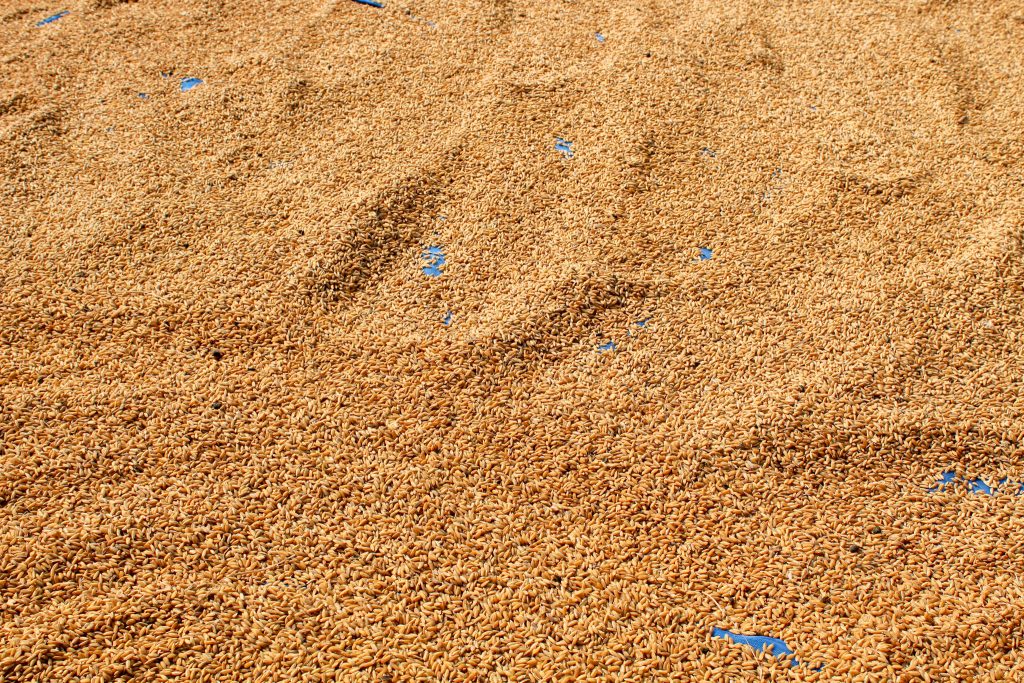
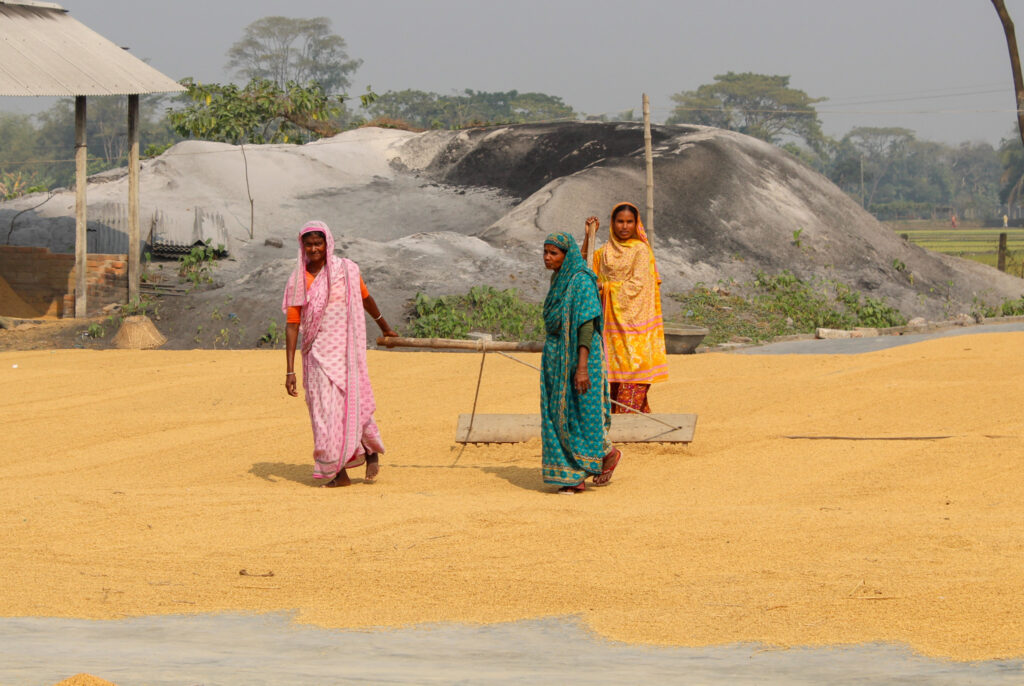
The grain moisture content that avoids breakage at harvest and threshing may be too high for effective storage or milling. Drying is usually necessary before cereals can be safely stored or processed. Natural drying or sun drying is a low-cost method used widely by smallholder farmers. Mechanical drying reduces the drying time, allows improved moisture control, and avoids losses associated with drying in open air, but many remote farm producers lack access to mechanical drying technology. A safe moisture content for most crops is below 13 percent. Higher moisture levels will allow mold, fungal or aflatoxin growth resulting in In addition to reducing grain quality, aflatoxin is associated with up to 35 percent of child stunting.
Sun drying can expose grain to loss from birds, insects, and other animals, damage from rain or other weather events, and contamination from dirt, dust and insects that can diminish the value of the crop. Losses associated with weather may be growing more severe due to changes in climate. Properly used machine dryers can eliminate drying losses, but improper temperature control during mechanical drying can reduce grain quality and germination rates.
Drying losses vary widely but one example places the range from an average of 3.1% with open sun drying of paddy to an average of .39% with machine drying. (Alam 2019)
Finding the best alternative drying tools for different crops under different circumstances is the primary focus of much of the research. The cost of alternatives to natural or sun drying often place them out of reach for many smallholder farmers, so finding economical solutions is also of interest.
To read research about drying, refer to the table below.
Small scale dryers allow farmers or groups of farmers to dry grain before selling to a trader or consumers, or storing for household use. Grain dried to certain specifications is less likely to develop aflatoxins or molds in storage. Using hermetic storage options in combination with grain dryers can help farmers avoid postharvest losses.
Download ADMI’s complete assessment of Small Scale Batch Grain Dryers

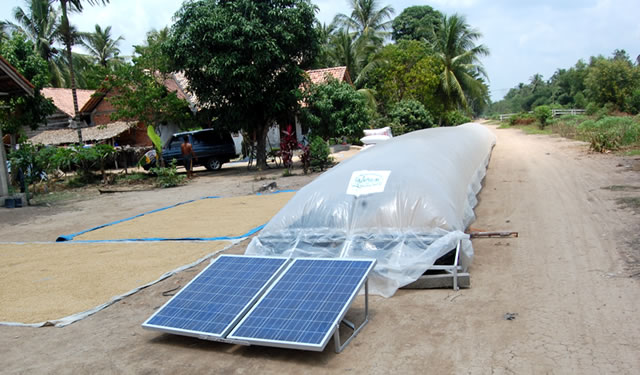
The solar bubble dryer uses solar energy for heating and electric energy for forcing air through the grains. It is a tunnel-type dryer, designed as an alternative to open field drying. Grain is placed in the bubble and a fan circulates the warm, dry air through the tunnel to dry the grain.
Capacity: 500 or 1,000 kg
Drying time: Reducing moisture by .5 percent every hour for rice or corn in good conditions. With optimal conditions, a crop can be brought from 22 to 14 percent moisture in 6 to 8 hours, according to the manufacturer.
Crops: tested for rice and maize
Fuel: solar or electric options available
Portable? yes, can be rolled up and transported easily
Ease of construction: professional
Product available for purchase? Yes, from GrainPro
Performance considerations: grain should be mixed regularly for optimum drying.
An instructional setup video is available from GrainPro.
FAQ from the International Rice Research Institute (IRRI)
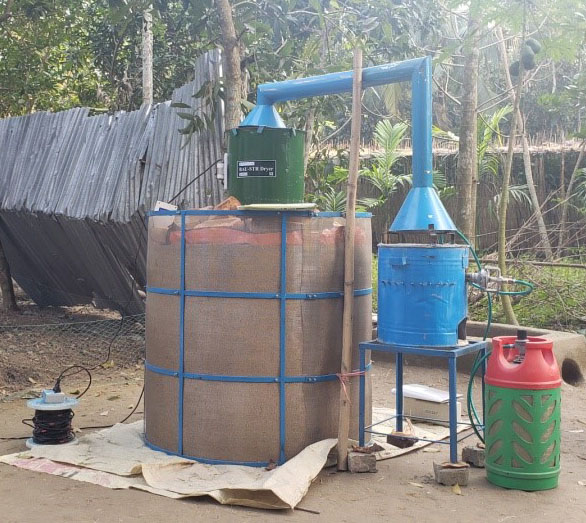
Circular bin dryers ventilate the grain outwards from a center column. They are compact, save floor space, and can be expanded or contracted to accommodate different batch sizes. Based on the Vietnamese SRR dryer design, modifications by ADMI partner Bangladesh Agricultural University include a mesh cage, improved blower, and an option for LP gas as a heat source.
Capacity: 500 kg and up, bin can be expanded to more than 500 kg
Drying time: 500 kg of paddy dried from 24.75% to 8.5% moisture content in 7.5 hours. Time can depend on air temperature and blower speed.
Crops: rice, maize
Fuel: Electricity needed for blower, heat generated by burning rice briquettes or LP gas
Portable? yes, can be disassembled and transported
Ease of construction: some technical expertise required
Performance considerations: grain should be mixed regularly for optimum drying
Detailed instructions and specifications from Bangladesh Agricultural University
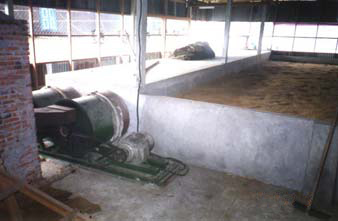
This classic simple flatbed dryer was developed in Vietnam. It can be constructed in 4-ton (SGH4) or 8-ton (SGH8) configurations.
Capacity: 4 (SGH4) or 8 tons (SGH8) per batch depending on configuration
Crops: paddy, maize
Drying time: reduce moisture by about 1.5% per hour; 4 ton batch of paddy dried from 25% to 15% in 9-11 hours
Fuel: generator or electricity connection for fan and additional biomass furnace for heat
Performance considerations: grain needs to be mixed by hand; cover over the dryer allows use in more weather conditions.
Portable? no
Ease of construction: no technical expertise required
Technical specifications and further information available from IRRI
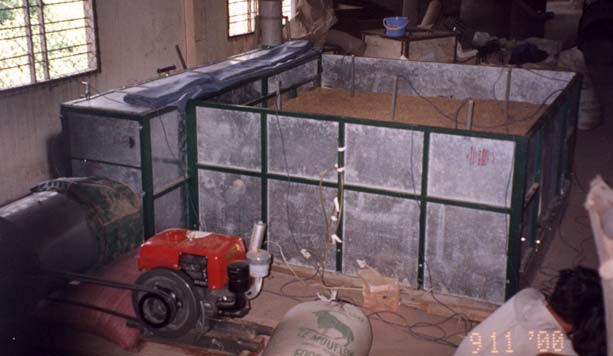
The reversible air dryer adds a cover to a standard flatbed dryer and an air channel to allow the operator to force air from the top down or from the bottom up. By reversing the airflow, these dryers reduce the moisture differential between the topmost and bottommost layers of grain, thereby increasing the consistency in drying.
Capacity: 500 kg up to 12 tons
Drying time: reduce moisture by about 1.15% per hour; an 8-ton batch of paddy can be dried from 24% to 12.5% moisture content in 9-11 hours.
Crops: paddy, whole coffee, coffee bean, pulped coffee, peanuts
Fuel: generator or electricity connection for fan and additional biomass furnace for heat
Portable? no
Performance considerations: Due to reverse flow drying, grain does not need to be mixed.
Read more about flat-bed dryers from the IRRI Knowledge Bank.
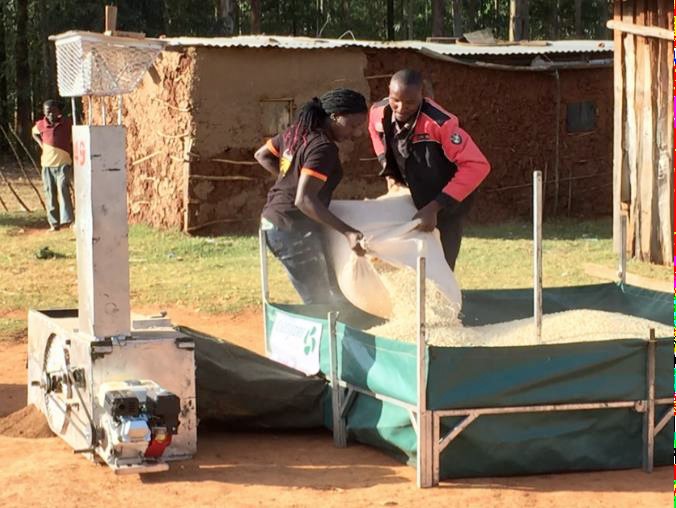
The Easydry M500 dryer is a small collapsible flatbed dryer designed to be portable, unlike the conventional flatbed. In addition to portability, it differs from the conventional flatbed dryer by using a heat exchanger after the blower, so that clean air is blown through the grains to be dried.
Capacity: 500 or 1,000 kg
Drying time: for 500 kg, the dryer can reduce moisture by about 1.6% per hour; a batch of maize can be dried from 17% to 13% moisture content in 2.5 hours.
Crops: paddy, whole coffee, coffee bean, pulped coffee, peanuts
Fuel: generator or electricity connection for fan and additional biomass furnace for heat
Portable? yes
Performance considerations: Grain needs to be mixed frequently.
Ease of construction: technical expertise required
Download the EasyDry user manual from ACDI-VOCA
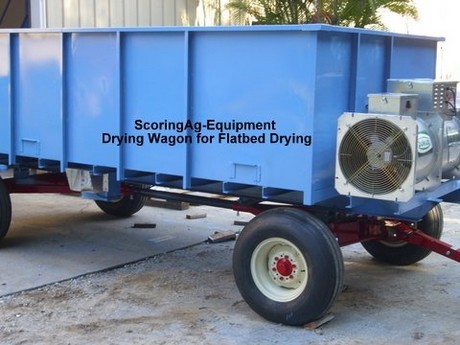
The Flatbed Wagon Dryer is a completely self-contained mobile flatbed dryer, which is commercially available. This dryer can be shipped into a standard 20-foot shipping container anywhere in the world. It is designed for precision drying and contains a thermo-humidistat, which regulates the heater to bring the product to the desired moisture content.
Capacity: 215 bushels and 315 bushels
Drying time: reduce moisture by about 1.67% per hour; the 215 bushel dryer takes about 3 hours per 5% moisture reduction.
Crops: maize, but steel mesh can be customized to accommodate finer grains including flaxseed, rice, and wheat
Fuel: electricity
Portable? yes
Ease of construction: professional production required
Performance considerations: No grain mixing necessary. Difficult to use in poor electricity supply situations. Sides are 9 feet high, which could make loading difficult.
Learn more about the drying wagon, including a demo video
| Titles | Authors | Tags | Publication Date | Category |
|---|---|---|---|---|
Scope of BAU-STR in Existing Paddy Drying System of Bangladesh | Saha, Chayan Kumer, Md. Ashraful Alam, Md. Monjurul Alam,et al. | Drying, Paddy, PHL Technology | 2018 | Journal Article |
Roy, Dipika, Chayan Kumer Saha, Md. Ashraful Alam, et al. | Drying, Paddy, PHL Technology | 2020 | Journal Article | |
Mechanical Drying of Paddy Using BAU-STR Dryer for Reducing Drying Losses in Bangladesh | Alam, Md. Ashraful, Chayan Kumer Saha, and Md. Monjurul Alam | Drying, Paddy, PHL Technology | 2019 | Journal Article |
Effect of Hot Air Velocity on Drying Kinetics Undergoing STR Drying of Paddy | Kumar, Ashok, Satish Kumar, Sanoj Kumar, et al. | Drying, Paddy, PHL Technology | 2017 | Journal Article |
ADM Institute for the Prevention of Postharvest Loss
1301 W. Gregory Dr.
60 Mumford Hall
Urbana IL 61801
+1 217-333-5115